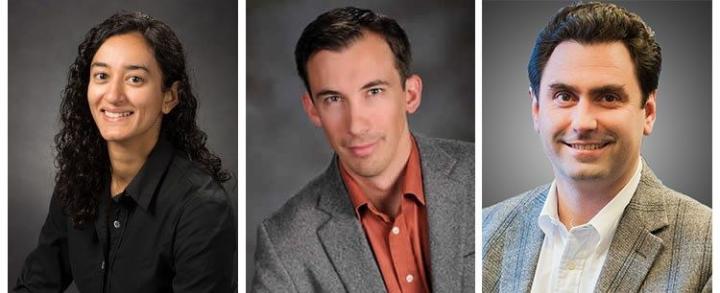
Credit: Virginia Tech
Virginia Tech researchers were recently awarded $2.4 million in funding from the U.S. Department of Energy’s Advanced Research Projects Agency-Energy (ARPA-E) to accelerate the development of multiple concepts in fusion energy technology through theory, computational modeling, and experimental validation.
Bhuvana Srinivasan, Colin Adams, and Stefano Brizzolara of the Kevin T. Crofton Department of Aerospace and Ocean Engineering, along with collaborators at the Princeton Plasma Physics Laboratory, will apply a versatile set of computational plasma modeling capabilities to better understand and advance the performance of lower-cost fusion concepts. The three-year project will bring together expertise from the fields of plasma physics and ocean engineering.
According to Srinivasan, nuclear fusion has the potential to meet terrestrial energy demands in perpetuity as far as human time scales are concerned. However, controlled thermonuclear fusion remains one of the biggest unsolved problems of the previous and present centuries.
“For most fusion concepts, theory has been trailing experiments,” said Srinivasan. “Significant advances in theory are necessary to overcome a multitude of scientific and engineering challenges and to support stable operation of experiments that can eventually deliver power to the grid. The work of Virginia Tech’s capability team will directly assist concept teams in their design, optimization, and in predicting and mitigating instabilities, losses, and other factors that could potentially prevent the concepts from succeeding.”
Specifically, the team at Virginia Tech will be improving capability in theory, modeling, and validation for a range of lower-cost, innovative fusion concepts. The team will do this using high-fidelity fluid and kinetic models, incompressible magnetohydrodynamic liquid metal models, and validation experiments to understand plasma dynamics, plasma-material interactions, and the response of liquid metals to the environment within fusion reactors.
The primary focus of the capabilities team is twofold. One aspect is to study the plasma dynamics and stability of steady-state as well as pulsed fusion concepts. The second aspect is to study the effects of a liquid metal wall that may interact with the plasma in some fusion concepts. Most fusion experiments contain a plasma that interacts with solid walls and electrodes within the device. Since the plasma is very hot (up to 100,000,000 ºC), the plasma particles hit the wall and electrode with enough energy to cause erosion and substantial damage.
Adams will be experimenting with interchanging the solid metal wall for a liquid metal wall to lessen the erosion issues. By driving very large electrical currents directly into a liquid metal in short timescales, the team will be able to look at the behavior and response of liquid metal walls to current and magnetic field pulses relevant to fusion regimes.
Brizzolara brings his expertise in modeling multiphase incompressible magneto-hydrodynamic flows developed to study special underwater vehicle propulsors. He will extend computational capability to work on liquid metal response in the presence of these large currents. The inherent modeling capability will build on his expertise from modeling complex free surface flows with accurate resolution of waves and spray formation that affect the extremely short timescales and dynamic responses of pulsed fusion concepts.
Srinivasan will be involved in both aspects of the project, working with Princeton Plasma Physics Laboratory on fluid-kinetic modeling of plasma dynamics and stability, and with Adams and Brizzolara on the liquid metal response. Srinivasan has had several past collaborations with Princeton Plasma Physics Laboratory, working on computational capabilities to develop novel plasma modeling tools aimed to study fusion-relevant physics and physics relevant to plasma-based space propulsion. One specific contribution is an open-source simulation technology called Gkeyll, a state-of-the-art code that advances physics and numerical capabilities in plasma physics.
Virginia Tech received this competitive award from ARPA-E’s Breakthroughs Enabling Thermonuclear-fusion Energy program, also known as BETHE, which works to develop timely, commercially viable fusion energy technology with the goal of increasing the number and performance levels of lower-cost fusion concepts.
Selected BETHE projects span three research categories: concept development to advance the performance of inherently lower-cost but less-mature fusion concepts; component technology development that could significantly reduce the capital cost of higher-cost, more-mature fusion concepts; and capability teams to improve or make advances in theory and computation, models and diagnostics.
Virginia Tech’s BETHE program award will support five additional personnel, including two post doctoral research associates and three Ph.D. candidates in the Department of Aerospace and Ocean Engineering.
###
Written By Jama Green
Media Contact
Suzanne Irby
[email protected]
Original Source
https:/




